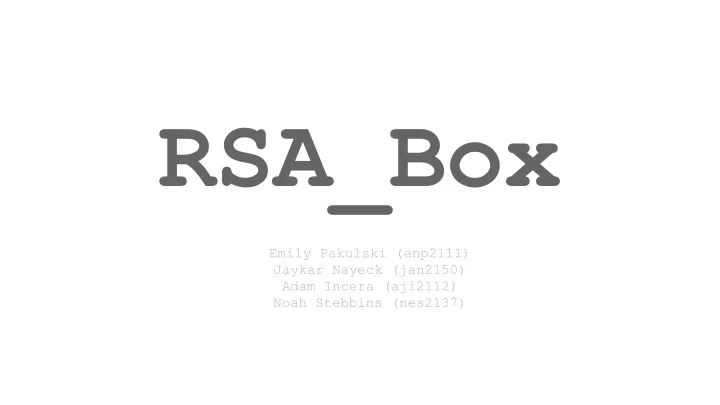

RSA_Box Emily Pakulski (enp2111) Jaykar Nayeck (jan2150) Adam Incera (aji2112) Noah Stebbins (nes2137)
“A fast and secure hardware accelerator for RSA encryption with a clear, simple interface for programmer use.”
Initial goals Provide a simple, well-defined interface for a host machine to carry out RSA cryptography operations on a dedicated piece of hardware. 1. Implement RSA algorithms using SystemVerilog. 2. Provide a software interface (Linux device driver, wrapper (in C), and example interface) to use the RSA Box.
High-level design
Original vs. final design Observation: parts of the RSA algorithm are “fixed costs”, others are “marginal costs”. Final design prioritizes lowering the overhead for repeated operations, rather than all operations -- highly costly Extended Euclid’s algorithm moved to software. Observation: implementing operations for large-bit values is time-consuming and not always possible. We changed our algorithms to use fewer operations and focused on speeding up encryption/decryption.
Contributions ● Jaykar: primary hardware framework writer, device driver, hardware/software interface (first version) ● Emily: C wrapper, hardware/software interface, C interface ● Adam: multiplier block and exponentiation ● Noah: private key generation and primality testing
Software/Hardware Interface ● Created 14 operation “ISA” that C wrapper sends to device driver to communicate with hardware. ● Lesson learned: standardize this earlier. ● OS was really helpful -- we struggled with the device driver lab3 code.
Private Key Generation (Software) ● Private Key: Extended Euclid’s in Python ○ computes modular multiplicative inverse → private key, piped into C ● Public Key: ○ initial approach: Miller-Rabin + Linear Backoff ○ final approach: hard-coded list of 64 bit primes
Hardware implementation ● Optimized modular multiplication from 6 cycles to 2 cycles per bit ● Set up a parallel block for modular exponentiation so encryption and decryption can run simultaneously
Encrypting & Decrypting (Hardware) ● Modular multiplication block ○ Multiplies two 128-bit numbers and reduces on a 128- bit modulus in 257 clock cycles ● Modular exponentiation block ○ Performs exponentiation in O(n) time where n is the bit length of the exponent
Modular Exponentiation Algorithm Source: http://en.wikipedia.org/wiki/Modular_exponentiation
Where we struggled (Git history) Tl;dr: Should have taken the pre-reqs. Advanced Logic Design would have been nice.
Recommend
More recommend